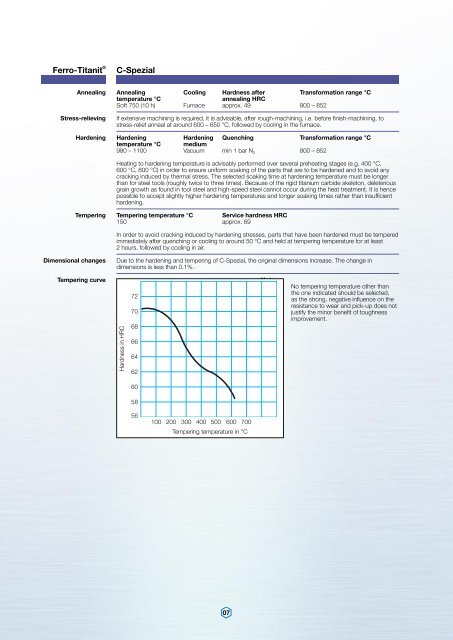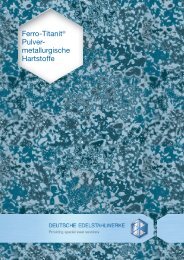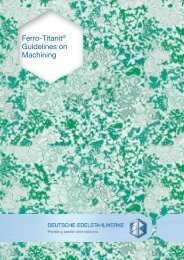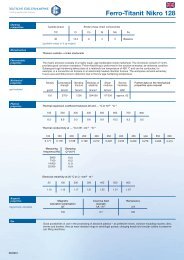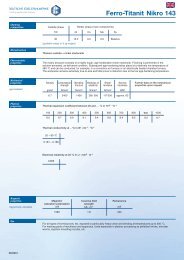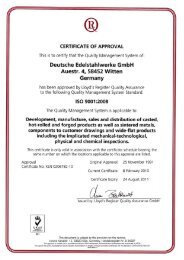Ferro-Titanit - Deutsche Edelstahlwerke GmbH
Ferro-Titanit - Deutsche Edelstahlwerke GmbH
Ferro-Titanit - Deutsche Edelstahlwerke GmbH
Create successful ePaper yourself
Turn your PDF publications into a flip-book with our unique Google optimized e-Paper software.
<strong>Ferro</strong>-<strong>Titanit</strong> ®<br />
C-Spezial<br />
Annealing Annealing Cooling Hardness after Transformation range °C<br />
temperature °C<br />
annealing HRC<br />
Soft 750 (10 h) Furnace approx. 49 800 – 852<br />
Stress-relieving<br />
If extensive machining is required, it is advisable, after rough-machining, i.e. before finish-machining, to<br />
stress-relief anneal at around 600 – 650 °C, followed by cooling in the furnace.<br />
Hardening Hardening Hardening Quenching Transformation range °C<br />
temperature °C medium<br />
980 – 1100 Vacuum min 1 bar N 2 800 – 852<br />
Heating to hardening temperature is advisably performed over several preheating stages (e.g. 400 °C,<br />
600 °C, 800 °C) in order to ensure uniform soaking of the parts that are to be hardened and to avoid any<br />
cracking induced by thermal stress. The selected soaking time at hardening temperature must be longer<br />
than for steel tools (roughly twice to three times). Because of the rigid titanium carbide skeleton, deleterious<br />
grain growth as found in tool steel and high-speed steel cannot occur during the heat treatment. It is hence<br />
possible to accept slightly higher hardening temperatures and longer soaking times rather than insufficient<br />
hardening.<br />
Tempering Tempering temperature °C Service hardness HRC<br />
150 approx. 69<br />
In order to avoid cracking induced by hardening stresses, parts that have been hardened must be tempered<br />
immediately after quenching or cooling to around 50 °C and held at tempering temperature for at least<br />
2 hours, followed by cooling in air.<br />
Dimensional changes<br />
Due to the hardening and tempering of C-Spezial, the original dimensions increase. The change in<br />
dimensions is less than 0.1%.<br />
Tempering curve<br />
Hardness in HRC<br />
72<br />
70<br />
68<br />
66<br />
64<br />
62<br />
Note:<br />
No tempering temperature other than<br />
the one indicated should be selected,<br />
as the strong, negative influence on the<br />
resistance to wear and pick-up does not<br />
justify the minor benefit of toughness<br />
improvement.<br />
60<br />
58<br />
56<br />
100 200 300 400 500 600 700<br />
Tempering temperature in °C<br />
07


